Are inefficient workflows slowing you down?
Juggling fragmented tools and manual processes drains productivity. It leaves your team struggling to coordinate resources and track performance effectively.
This leads to costly errors and missed deadlines. Frequent miscommunication and frustration become the norm when your team lacks a single source of truth.
According to KBV Research, 78% of manufacturers report inefficiencies from manual methods. This costs businesses dearly, draining productivity and hindering growth potential.
The right software can solve this. It helps you unify your operations completely and regain control over your entire workflow.
In this article, I’ll guide you through the best operations management software. I will show you tools designed to streamline your processes and boost team efficiency.
You’ll discover how to eliminate manual work, improve collaboration, and get the real-time data needed to drive growth and make smarter decisions.
Let’s get started.
Quick Summary:
| # | Software | Rating | Best For |
|---|---|---|---|
| 1 | monday.com → | Growing mid-sized teams | |
| 2 | ClickUp → | Flexible teams of all sizes | |
| 3 | Smartsheet → | Enterprise project leaders | |
| 4 | Asana → | Large enterprises & teams | |
| 5 | Wrike → | Mid-to-large organizations |
1. monday.com
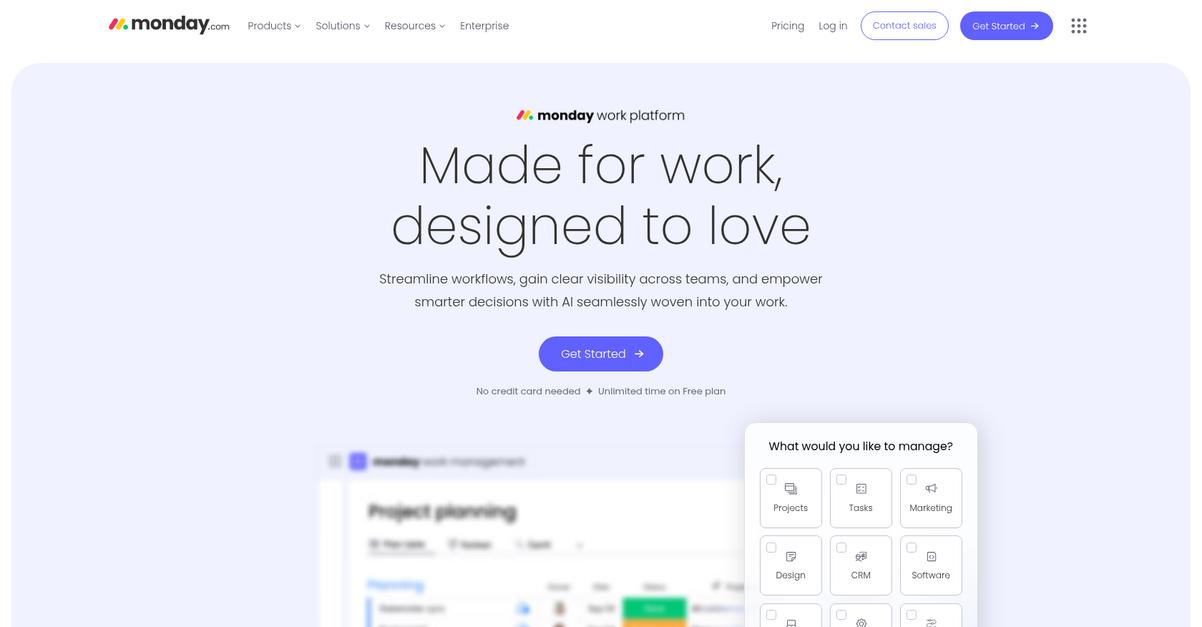
Struggling with fragmented operations and limited visibility?
monday.com streamlines your workflows, allowing you to gain clear visibility across teams. This helps you track performance and maintain quality, even as your business grows.
This means you can say goodbye to disconnected systems that drain productivity, as monday.com helps you make smarter decisions with AI seamlessly woven into your work.
It’s time to elevate your work.
monday.com introduces a unified platform for every team, including operations, finance, IT, and HR. It centralizes everything from event and order management to facilities and finance requests.
This helps you scale operations effortlessly, ensuring all your processes are running smoothly. monday.com allows you to easily transform any data into visually stunning dashboards, providing real-time oversight across your business.
Additionally, monday.com helps you automate routine tasks and gain AI-generated insights, freeing up your team to focus on core activities. You can customize the platform with drag-and-drop flexibility to build robust workflows, integrating with hundreds of ready-to-use apps and developing custom solutions using their open API.
The result is truly seamless, automated oversight.
If you’re looking for specialized solutions to streamline operations in a niche industry, my article on 11+ Best Dry Cleaning Software provides detailed insights.
Key features:
- Workflow Streamlining: Automate tasks and gain clear visibility across teams to reduce manual work and ensure seamless operations from beginning to end.
- AI-Powered Insights: Make smarter decisions with AI seamlessly integrated into your workflows, providing intelligence for risk analysis and rapid problem-solving.
- Customizable Dashboards: Transform your data into visually stunning dashboards, giving you real-time oversight and actionable insights to drive efficiency and growth.
Learn more about monday.com features, pricing, & alternatives →
Verdict: monday.com simplifies complex operational challenges by unifying workflows and providing real-time visibility. With capabilities like AI-driven insights and flexible customizations, monday.com is ideal for leaders seeking the best operations management software to boost team efficiency and control.
2. ClickUp
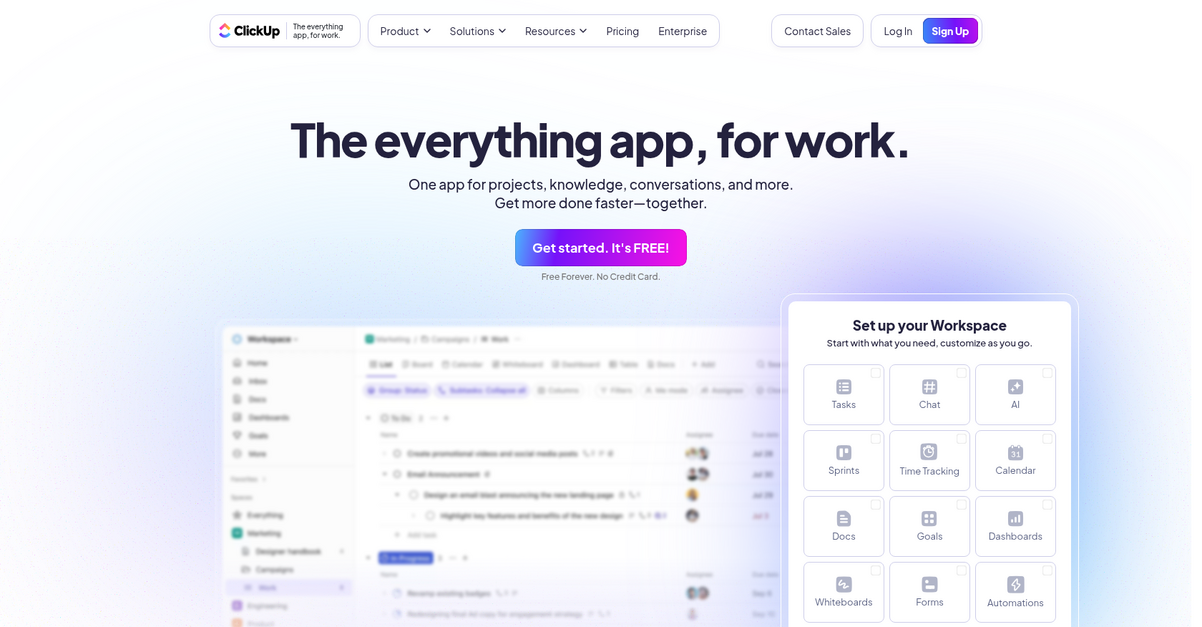
Struggling with fragmented tools and inefficient workflows?
ClickUp integrates tasks, chat, docs, and calendars, centralizing your entire operation in one place. This means you can finally end the constant app-switching that steals your time and kills team productivity.
With all your projects, knowledge, and conversations consolidated, everything just clicks, giving your team the power to maintain flawless operations.
Let’s fix your work.
ClickUp tackles these challenges by offering “the everything app for work,” designed to boost productivity and save your team a day every week. Here’s how it unifies your operations.
You can start with basics like tasks and chat, then customize with hundreds of features such as AI, time tracking, Gantt charts, and automations. This means you can tailor your workspace to exactly what you need, enhancing your team’s efficiency without unnecessary clutter.
Additionally, ClickUp’s “Connected Brain” allows you to search across all your apps, instantly pulling answers from Google Drive, Salesforce, and more, which significantly reduces manual work and improves collaboration. Plus, it offers AI-powered writing support to accelerate content creation and streamline communication across teams.
The result: seamless oversight and actionable insights.
While we’re discussing enhancing overall team efficiency and control, understanding how to best manage customer experiences is equally important for long-term business success.
Key features:
- All-in-one workspace: Consolidate tasks, docs, chat, and calendars to reduce app-switching and centralize your team’s projects, knowledge, and conversations.
- Customizable workflows: Tailor your workspace with features like AI, automations, time tracking, and dashboards, adapting ClickUp to your specific operational needs and ensuring flexibility.
- Connected AI and Search: Utilize “ClickUp Brain” for company-wide AI integration and “Connected Brain” to search across all your apps for instant answers and enhanced productivity.
Learn more about ClickUp features, pricing, & alternatives →
Verdict: ClickUp’s comprehensive features, from customizable workflows to integrated AI and enterprise search, directly address operational inefficiencies and fragmented tools. This makes it an ideal solution to boost your team’s efficiency and control, proving it as a strong candidate for the best operations management software.
3. Smartsheet

Struggling with fragmented tools and inefficient operations?
Smartsheet steps in with an AI-powered platform to streamline your workflows and connect your teams. This means you can finally eliminate bottlenecks and gain a unified view across all your projects.
You can make better investment decisions, deliver efficient services, and optimize marketing campaigns. This helps you achieve alignment with organizational goals.
Here’s your solution.
Smartsheet solves the problem of disconnected systems by offering enterprise-grade work management. This ensures your operations leaders and business owners gain predictive insights for faster, smarter scaling.
It centralizes everything from project and portfolio management to creative operations, allowing you to manage projects, automate workflows, and build solutions at scale. You can also integrate your favorite apps, keeping all your work in sync and your team in the loop.
Additionally, Smartsheet offers features like digital asset management, resource management, and secure request management. Its AI-driven intelligent formulas and data insights empower your team to move quickly, lead projects with precision, and focus on innovation rather than repetitive tasks, saving valuable time.
The result is seamless oversight and enhanced control.
If you’re also optimizing other specific business operations, my guide on best online food ordering software explores industry-specific solutions.
Key features:
- AI-powered platform: Transforms work management into a predictive engine, helping you work the way you want, at the speed you need for precise project and portfolio leadership.
- Workflow automation and collaboration: Simplifies processes, reduces errors, and enables real-time teamwork, sharing updates, and keeping everyone in the loop, wherever they are.
- Comprehensive solutions: Manages project and portfolio, marketing and creative, services delivery, and ensures oversight over key programs for diverse organizational needs.
Learn more about Smartsheet features, pricing, & alternatives →
Verdict: Smartsheet provides robust features like AI-powered insights, workflow automation, and extensive collaboration tools that make it suitable as a top best operations management software. It allows you to track over 200 mission-critical projects and save 30+ days on customer invoice collection.
4. Asana
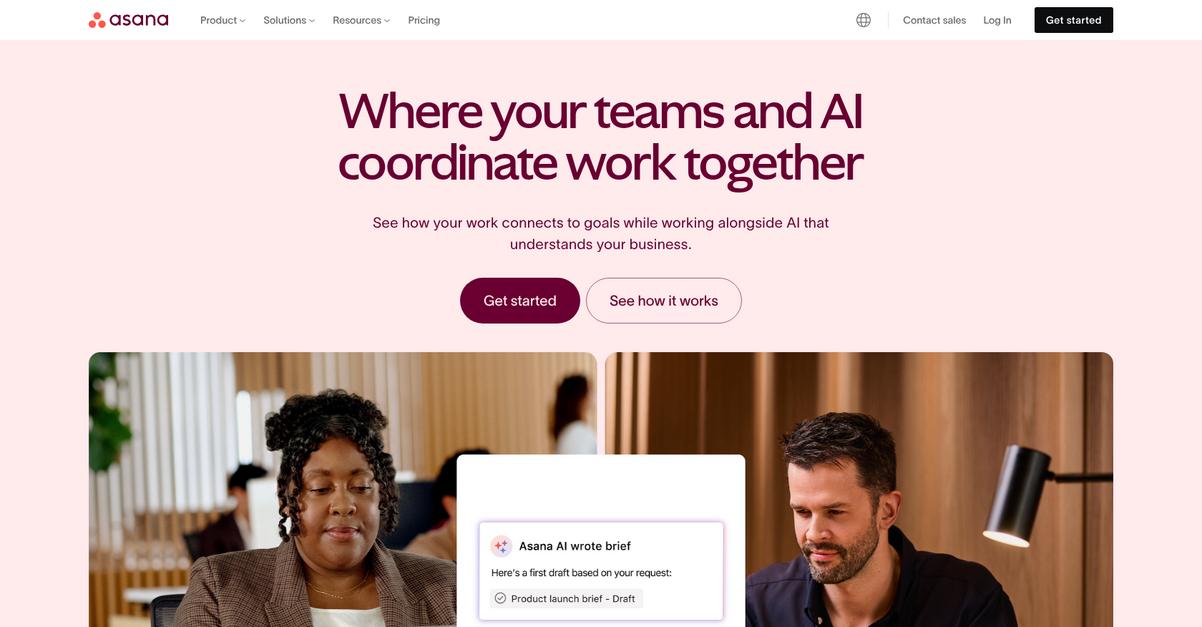
Struggling with fragmented tools and inefficient operations?
Asana offers robust project management, workflow automation, and AI Studio capabilities, designed to bring all your work into one unified platform.
This means you can easily connect strategic goals to the teams helping achieve them, allowing for clear processes that remove as many blockers as possible.
Here’s how Asana helps.
Asana solves the problem of disconnected systems by centralizing your operations.
You can leverage features like resource management and goals and reporting to visualize team staffing and align individual work with broader organizational objectives. This provides air traffic control for your entire business, ensuring clear visibility.
Additionally, with over 300 app integrations, Asana connects with tools you already use, amplifying your impact with AI that understands your business context. It handles tasks for you, letting your teams focus on achieving goals faster through automated workflows and smart project intake.
The result is increased clarity and accountability.
Key features:
- Project and Goal Management: Plan, track, and complete projects while connecting every team’s work to overarching organizational goals, ensuring everyone is aligned.
- Workflow Automation & AI Studio: Automate routine tasks and leverage Asana AI to handle work with full business context, accelerating team progress and goal achievement.
- Resource Management & Integrations: Visualize team capacity and available resources, seamlessly integrating with over 300 existing enterprise tools for a unified ecosystem.
Learn more about Asana features, pricing, & alternatives →
Verdict: Asana excels in providing comprehensive project, resource, and goal management, making it an excellent choice if you’re looking for the best operations management software. Its AI and extensive integrations streamline workflows and boost team accountability, helping organizations like 85% of Fortune 100 companies achieve their objectives.
5. Wrike
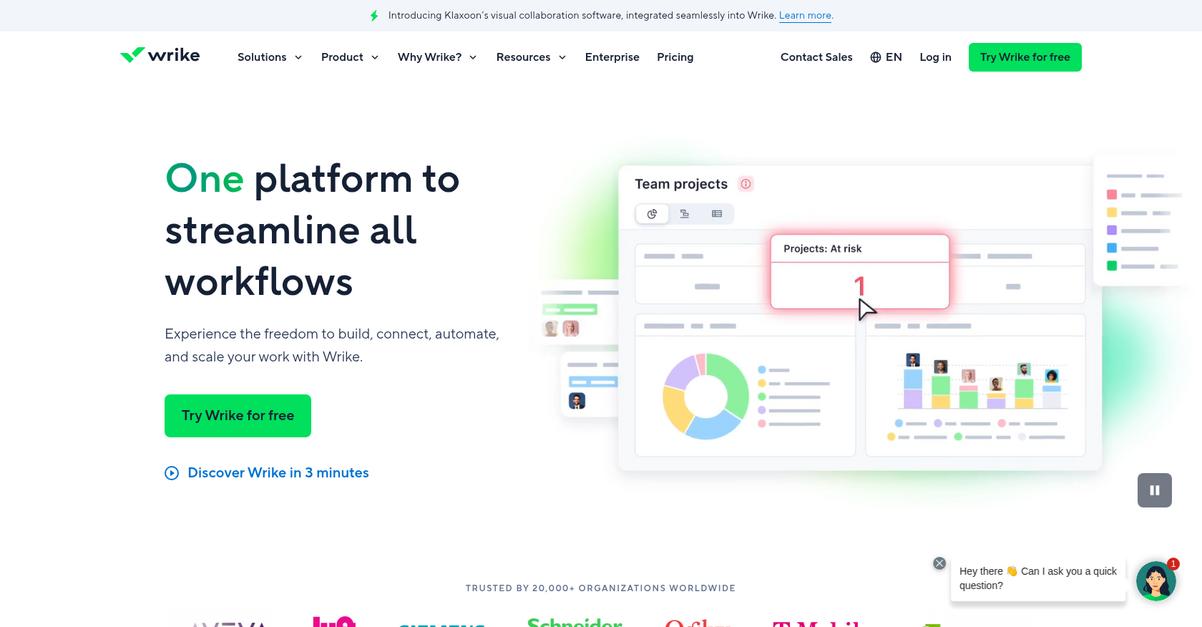
Are fragmented tools hindering your team’s productivity?
Wrike offers a unified platform designed to streamline your workflows, allowing you to build, connect, automate, and scale operations with ease. This means you can centralize work and communication.
It helps you envision work and capture essential information to kick-start projects, bringing multiple teams into one place for game-changing visual collaboration and seamless processes.
This allows work to truly flow.
Wrike introduces optimal visibility across projects and departments, giving you all the necessary details and updates in one place with 360-degree oversight. You can connect cross-functional teams and easily allocate resources as needed, preventing miscommunication and missed deadlines. This platform features intuitive tools like task management and proofing, accelerating delivery and saving you hours from excessive emails and meetings. Additionally, AI-driven analytics empower data-driven decisions, offering real-time reports in visual dashboards and using AI to predict risks and allocate resources effectively. The result is improved workflows and impressive outcomes.
Key features:
- Centralized Ideation Hub: Wrike provides a powerful hub for envisioning work, capturing information, and leveraging visual collaboration, dynamic request forms, and AI to align teams.
- 360° Project Visibility: Gain optimal visibility across all projects and departments using Gantt charts and resource management tools, helping you allocate resources efficiently.
- Automated Workflows & Analytics: Define and trigger automated workflows to eliminate manual efforts, while AI-driven analytics provide dashboards and real-time data for informed decision-making.
Learn more about Wrike features, pricing, & alternatives →
Verdict: Wrike is recognized by over 20,000 organizations worldwide as a robust solution to make work flow, providing intuitive tools that accelerate delivery and save your team hours. With its ability to unify disparate teams and streamline processes, Wrike stands out as an excellent choice for the best operations management software.
6. NetSuite
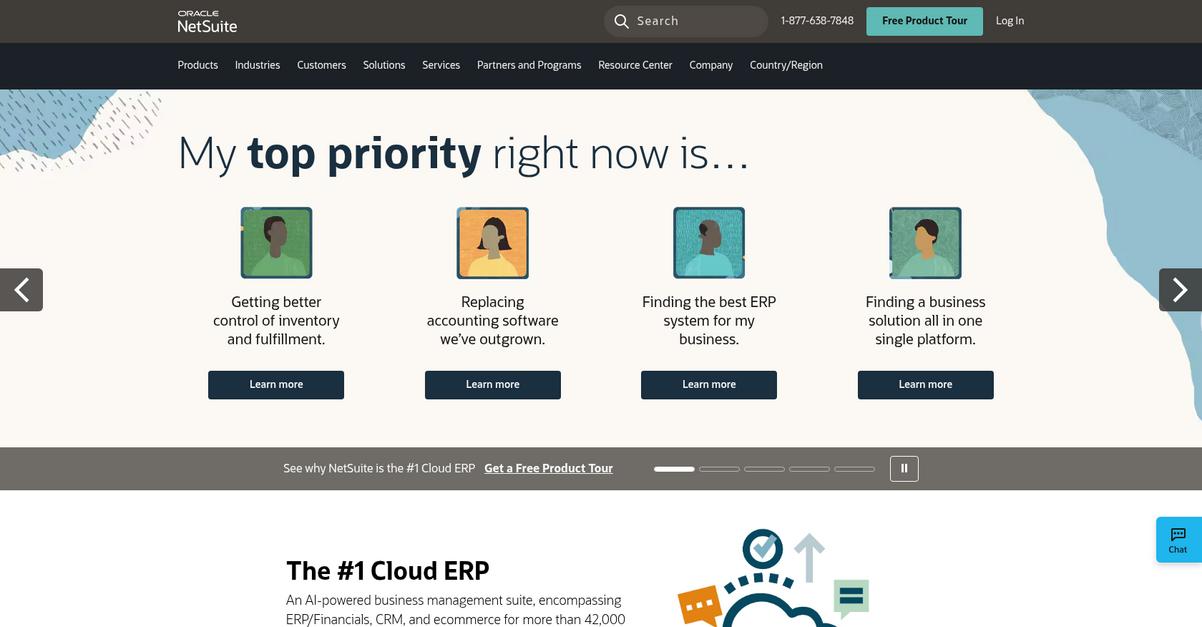
Are your disconnected systems draining team productivity?
NetSuite brings all your core business processes into one unified platform.
This means you can easily connect your finance, sales, and service teams, giving you a single source of truth for your entire business. The result is better decision-making.
Here’s how to gain complete control.
NetSuite offers a single system for your entire business, eliminating fragmented tools and manual processes. This centralizes everything from financial management to project execution, giving you unified insights.
You can streamline your workflows and automate tasks, reducing manual effort and improving efficiency. This allows you to focus on strategic growth rather than administrative burdens.
Additionally, NetSuite provides comprehensive business intelligence, offering real-time data and analytics across all departments. You gain actionable insights to optimize operations, improve resource coordination, and make data-driven decisions that drive agility and ultimately, customer value.
Simplify your operations today.
Key features:
- Unified Business Processes Consolidate finance, sales, and service onto one platform, eliminating data silos and providing a consistent view across your organization.
- Automated Workflows Streamline repetitive tasks and manual processes, freeing up your team to focus on higher-value activities and improve overall efficiency.
- Real-time Business Intelligence Access comprehensive dashboards and analytics for immediate insights into financial performance, operational metrics, and project status.
Learn more about NetSuite features, pricing, & alternatives →
Verdict: NetSuite’s unified platform, automation capabilities, and real-time intelligence make it ideal for operations leaders seeking to overcome inefficient workflows and fragmented tools. If you need a comprehensive, single source of truth for seamless oversight, NetSuite is a strong contender for the best operations management software.
7. Odoo

Struggling with disconnected operations and manual processes?
Odoo brings together a vast collection of integrated business applications, offering specific tools for everything from inventory to project management.
This means you can say goodbye to fragmented systems and hello to a single platform for your entire business, simplifying daily tasks and empowering your team with the right tools for every job. The result?
Streamlined, efficient workflows.
Odoo simplifies your operations, providing a centralized platform that covers all your company needs, from accounting and sales to human resources and supply chain management. This comprehensive approach means all your business functions are on one platform, reducing data entry and improving visibility. With apps for inventory, manufacturing, and quality control, you can optimize your supply chain, track performance, and maintain high standards. Additionally, the Project and Planning apps help coordinate resources and track team performance, ensuring projects stay on schedule. Plus, features like Helpdesk and Field Service improve customer satisfaction and service delivery.
Imagine your entire business running on a single, intuitive platform.
Key features:
- Comprehensive Business Apps: A wide array of integrated applications for finance, sales, supply chain, HR, and services, streamlining every aspect of your operations.
- Optimized Productivity: Experience true speed and reduced data entry with smart AI and a fast UI, designed to complete operations in less than 90ms.
- Highly Customizable Platform: Use Odoo Studio to automate actions, design custom screens and reports, and leverage 40K+ community apps for tailored solutions.
Learn more about Odoo features, pricing, & alternatives →
Verdict: Odoo stands out as a highly effective best operations management software solution due to its integrated suite of apps, covering everything from inventory and manufacturing to project management and HR. Its focus on simplifying processes, reducing data entry, and providing a unified platform helps businesses overcome fragmentation and inefficiency, as seen in KPMG Belgium’s 80% reduction in accounting document processing time.
8. Scoro

Struggling with fragmented tools and inefficient workflows?
Scoro unifies project, resource, and financial management to deliver seamless operational oversight.
This means you can streamline processes, manage capacity, and control margins with a single source of truth, eliminating blind spots and reducing manual work.
Simplify your operations today.
Scoro solves your fragmented systems by managing your entire project lifecycle on one platform, from estimating scope to tracking results and issuing invoices. This allows you to gain complete, real-time overviews of project performance.
Additionally, Scoro’s powerful resource planning capabilities help you forecast work for optimal utilization, enabling proactive decisions on staffing and ensuring your team’s workloads are balanced. You’ll truly understand which projects, clients, or services are profitable and which are eating into your margins, ensuring you’re always making money.
Plus, you can boost cross-team collaboration by uniting everyone on a single platform, keeping all project information accessible. Scoro AI, through your smart companion ELI, provides instant insights and automates actions with natural language interpretation of your business data.
Gain visibility and control.
If your operations involve specialized fields, consider my comprehensive review of best clinical trial management systems to learn more.
Key features:
- Project Management: Deliver projects from quote to cash with integrated sales, delivery, and financial management for real-time performance insights.
- Resource Planning & Capacity: Plan and forecast work for optimal utilization, preventing burnout and ensuring balanced team workloads for maximum efficiency.
- Reporting & Dashboard: Gain deep insights into project progress, results, and future outlook, enabling you to identify profitable ventures and control costs effectively.
Learn more about Scoro features, pricing, & alternatives →
Verdict: Scoro is ideal for operations leaders seeking a unified platform to overcome fragmented tools and manual processes. It streamlines workflows, enhances visibility, and drives profitability by connecting projects, resources, and financials, making it a top contender for best operations management software.
9. Kissflow
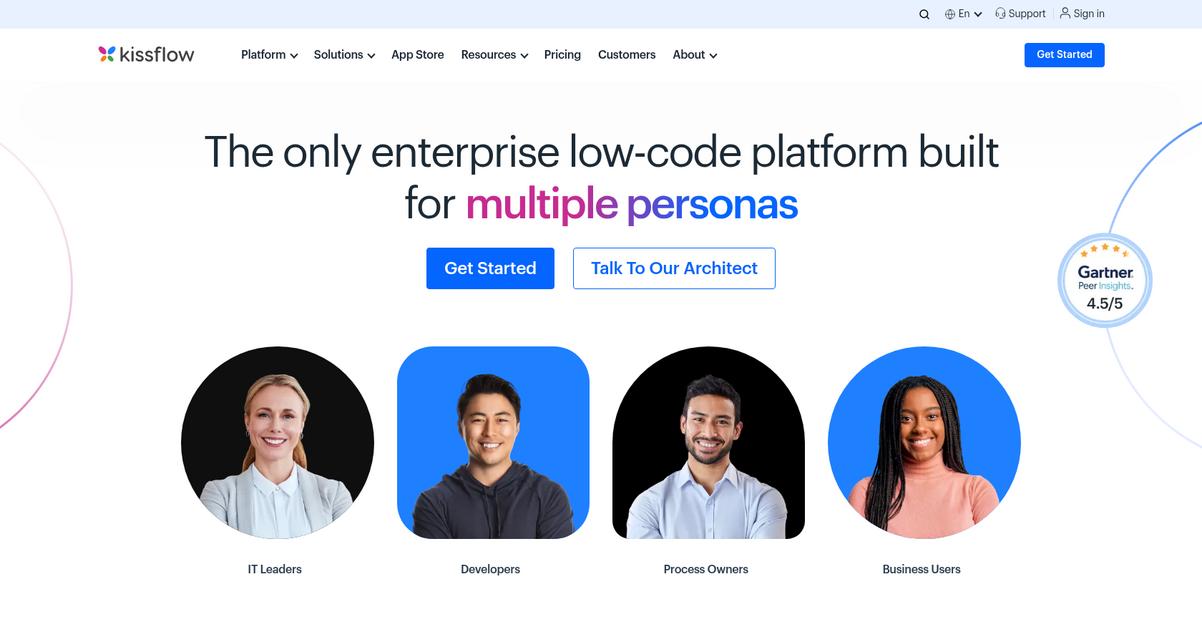
Tired of fragmented operations and manual processes?
Kissflow offers an enterprise low-code platform empowering your team to build and automate. This means you can create fully functional applications and streamline workflows in minutes.
The struggles with inefficient workflows, outdated manual processes, and disconnected tools often hamper visibility across projects and teams.
Here’s how you can achieve seamless, automated oversight.
Kissflow introduces a new paradigm in low-code development, empowering everyone, from IT leaders and developers to process owners and business users. You can leverage the power to turn your ideas into reality.
This platform offers no-code, automated workflows, allowing you to develop and deploy simple or complex processes quickly. You can also handle ticketing and support requests on customizable boards for next-level case management. Additionally, Kissflow provides instant connections to all your systems using easy no-code connectors, ensuring integrated operations.
You can also make better decisions with customized, actionable insights from visual data on a flexible interface, enhancing your control and efficiency. The result is faster work, improved collaboration, and increased agility.
Key features:
- Workflow Orchestration: Develop and deploy simple or complex workflows in minutes, eliminating manual bottlenecks and ensuring processes flow smoothly across your organization.
- App Builder & Integrations: Create fully functional applications using low-code/no-code tools and seamlessly connect all your essential systems with easy, no-code connectors.
- Case Management & Boards: Handle ticketing and support requests efficiently on customizable boards, providing next-level case management to get work done faster.
Learn more about Kissflow features, pricing, & alternatives →
Verdict: Kissflow excels as the best operations management software by empowering multiple personas with low-code and no-code tools. Its capabilities like automated workflows, app building, and case management directly address pain points, ensuring streamlined operations, improved visibility, and enhanced decision-making for your team.
Conclusion
Still struggling with operational chaos?
Choosing the right software feels overwhelming. So many tools promise a fix, yet your team remains stuck with fragmented workflows and limited visibility.
According to IMARC Group, the right tools can reduce production errors by 40-50%. Imagine making decisions 15-25% faster just by using real-time data. That’s a powerful competitive advantage.
So, what’s the best choice?
From my experience, monday.com is the top choice for unifying your workflows. It provides the clear, real-time visibility needed to manage your entire operation.
Its customizable dashboards and AI-powered insights are genuine game-changers. I consider it the best operations management software because it truly centralizes everything for your team.
For specific operational needs, such as in healthcare, exploring medical lab software can provide tailored solutions.
I highly recommend you check out monday.com pricing. See for yourself how its features can align with your team’s budget and operational goals.
It’s time for seamless oversight.






